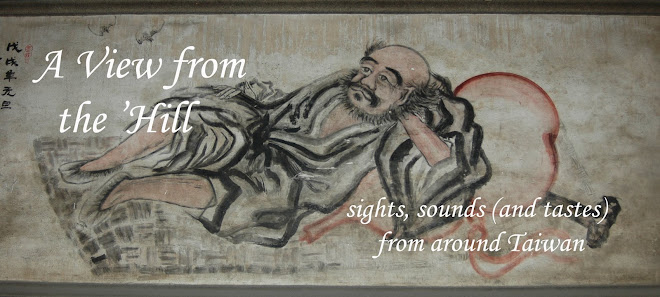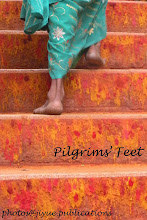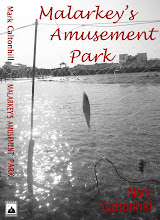"My First Triathlon"
(article in June's Amcham magazine: Taiwan Business Topics)
Two years ago I weighed 106 kilograms (about 233 pounds). The nearest I came to any sporting activity was when one friend cruelly asked if I had a basketball hidden under my shirt. Though I was athletic in my youth, over the years I’d spent too much time behind a desk, and consumed too many bottles of beer and bags of chips.
Still, high on my “bucket list” (things I want to do before kicking the bucket) was to compete in a triathlon – 1.5 kilometers of swimming and 40km of cycling, followed by 10km of running. Now I can check off that item, and while I haven’t won a race, I’ve lost weight, improved my fitness, and met a lot of friendly triathletes, many of them AmCham members.
Getting started was the biggest challenge, since for the life of me I couldn’t find where to sign up for a triathlon. Finally I found the Taiwan Racing website (www.taiwanracing.com ), subtitled “Follow Craig Johns & friends as they compete in triathlon, cycle and multisport events in Taiwan and around the world” and showing a picture of a blond curly-haired man standing beside a bike.
I fired off an email asking if Taiwan had any triathlons, and if so, were there any suitable for fatties like myself, and did he know of any ex-fatties with whom I could train. Johns replied that I would be welcome at any of the events listed at www.taipeimarathon.org.tw/contest.aspx (Chinese only). He said that some Taiwanese athletes participated, even though they couldn’t even swim, paddling around using a flotation device. He also recommended contacting a chap named Bill Bryson who helps organize regular training runs leaving the Taipei American School (TAS) campus at around 5 a.m. three times a week.
The next triathlon was in Kaohsiung in December, but I was too late to sign up. There was nothing then until April. Disappointed but excited, I signed up for two smaller events: Miaoli on April 11 and Hualien on May 29. I also signed up for a half-marathon in March, and then, since I’d already run that distance in training, changed my mind: “Heck, I might be ready for the full 42 kilometers,” I thought.
I emailed Bryson. He was very friendly, and invited me to any of the 30-kilometer Tuesday, 60-km Thursday, or 100-km Saturday runs. 
“Just how fast do you go?” I inquired.
“22-23kph for the hills, 28-29kph for the others – sometimes a little over 30kph.”
Gee, I thought, that’s fast. Just how ex-fat was he? Bryson, a lawyer with Jones Day, said that having lost about 45 kilograms, he weighed in around 100. He quickly added that he was now a top-5 triathlete in his age-group in Taiwan, and had qualified for the world half-Ironman championship (1.9-km swimming, 90-km cycling, 21-km running) held in Clearwater, Florida last year. Unfortunately he’d injured himself while training and missed the event. As compensation, he’d crossed a different item of his bucket list by entering and finishing the Taipei marathon in December last year.
I decided to put in a month or two of hard cycling, then see about joining Bryson’s group.
Leading expats
Johns, it turned out, wasn’t just a guy with a blog. Not only is he the top triathlete in Taiwan, but he’s also a coach of the Kaohsiung-based national triathlon team. Previously he had been aquatics director at TAS, and before that a member of the New Zealand national triathlon squad. 
Bryson met Johns at TAS about six years ago while getting back to swimming after a long lay-off. He had done a few triathlons in the United States after graduating law school in 1984, as well as the 28-km round-Manhattan swim. But since arriving in Taiwan in 1988, his weight had steadily increased. “Taiwan’s work ethic didn’t help, nor the country’s good food,” he says. Then two of his friends – both younger than him – had heart attacks, and Bryson knew it was time to get back in shape. Swimming and a Nordic trainer were the first steps, then cycling and eventually running. With Johns’ encouragement, he signed up for his first triathlon, Hualien in 2005, in which he came in around 16th in his age group, having taken more than an hour for the run.
Now in the 50-55 age bracket, Bryson has his own twist on the Taiwan work ethic, getting up at 4 a.m. for three sessions each week of cycling, three of swimming, and a number of runs. His bucket list now includes again qualifying for but this time making it to Clearwater, and doing a full Ironman. “Only one,” he stresses, “unless I qualify for Kona [the Hawaii site of the Ironman world championship]. In that case I’ll do two.”
Meanwhile, I pressed on with my preparations: 2,000 kilometers of cycling in January and another 1,250 in February, by which time I was down to a tidy 78.5 kilograms. But it didn’t last, as I spent the next three weeks bouncing between illnesses, only managing 196 kilometers for the whole of March. On March 21, I could complete only the first 21-km lap of the freeway marathon. I didn’t get an official time or even a souvenir towel; what I did get was sore and bleeding nipples for the next few days.
With a week to go before the Miaoli event, I called a few of Taiwan’s expatriate triathletes for some advice. Revital Golan, managing director of consulting firm Anemone Ventures, has herself only recently started to compete in cycle events and triathlons. “Don’t worry about your physical ability, just believe you can do it,” she told me. “It’s about your mental strength and will.”

Nor should I worry about the gear, she said. “All you really need is a reasonable bike, running shoes, and a swim suit and goggles. After your first race, you'll probably want to upgrade your bike and buy a tri-suit.” Also, although it was too late for this event, she recommended finding a training partner of similar ability or stronger, to encourage me to push harder.
“You won’t be first and you won’t be last, I can guarantee that,” said Simon Moore, a business manager with Air Products who has competed in triathlons throughout his six years in Taiwan and in the United States before that. “And hey, since it’s your first event, you’re guaranteed a personal best time.” He forgot to add: “If you finish.”

Acknowledging his growing passion for the sport, Moore finally bought a specialist time-trial bike last year after almost 20 seasons of competing on a regular road bike with clip-on TT bars. He took that to Hainan Island for the China half-Ironman, where he qualified for this year’s Clearwater event. But he emphasizes that the sport is about participating, not winning.
I called Bryson, apologized for not having made it to his pre-dawn rides despite his warm invitation, and asked for some last-minute advice. It was too late for any physical improvement, he said, but there was lots I could do in terms of nutritional preparation and race-day tactics.
Although for a “short” event like Miaoli, I wouldn’t be “hitting the wall” (marathon runners’ term for when the body runs out of available sugars after about 30 kilometers), he nevertheless recommended “carbo-loading” – that is, eating plenty of carbohydrates in the several days before a race. He also tries to avoid fresh fruit and vegetables over the last three days, since “you don’t want to be carrying all that roughage and be looking for a toilet as soon as you get going.”
“A couple of days before the race, check all your equipment, and go through your T1 and T2 procedures,” Bryson suggested, referring to the two transitions – from swim to cycle, and cycle to run.
“On the morning, three hours before the race, I drink some water and eat some salted rice crackers to replace calories lost during the night,” he continued. “One to two hours before the race is the ‘black-out period’ when you shouldn’t take any sugars. Your blood-sugar level rises, so your body produces insulin, which actually leads to a lower blood-sugar level and a feeling of drowsiness. In the last hour, I drink some more and take an FRS [free radical scrounger] gel. Before the race, I put on Body Glide.”
“Body Glide?”
“To stop chaffing, especially in the groin and nipples. You’ve heard of runner’s nipple?”
Unfortunately, I had not only heard of it, I’d experienced it. “I wish I’d called you a month ago,” I said.
“I put my towel on the ground to stand on, and put my helmet on the handlebars, and my sunglasses and race belt in the helmet. My spare tube, patch kit, and CO2 capsule are on the bike. I clip the bike shoes to the pedals. I have bike shoes that don’t need socks; getting socks over wet feet takes a lot of time. My running shoes don’t need socks either. For T2 I also have a water-bottle belt in which I put two bottles of water and two of sport drink, and it has a pocket for salt capsules and gels.”
“Gels?”
“Energy gels. But you need to train with them beforehand to get used to them. And drink water before and after you swallow them. Drink lots of water anyway. You have to stay ahead of dehydration. Drink small amounts, but don’t wait till you’re thirsty.”
“T2 is the toughest part of the triathlon. For 90 minutes during the swim and bike, your legs have been doing no weight bearing. Now you suddenly expect your legs to carry you. Not surprisingly, they object. The first kilometer of the run always sucks. One trick is to match your cycling cadence with your running cadence just before transition. And never stop for cramps.”
“Sockless shoes, race belt, drinks belt, gels, body glide, FRS…it sounds like a lot of equipment,” I said.
“Go see Howard,” Bryson answered.
Howard, I learned, is Howard Chen, a leading triathlete and cyclist, and owner of Howard’s Bike Co. (No. 27, Lane 22, Guangfu S. Rd.). I headed over to the store, and Howard turned up in person about 20 minutes after his assistant called to tell him there was an English-speaking person in the shop. I asked him what I needed to get started.

Entry-level aluminum time-trial bikes start at around NT$50,000, he said, and go as high as you want. NT$150,000-$200,000 would get me something nice – lightweight and aerodynamically fast, and equipped with carbon-fiber frame, forks, and wheels. Eighty percent of triathletes in Taiwan use road bikes, however, and entry level for one of those could be as low as NT$30,000.
What else would I need? Howard went through the list: helmet NT$1,500-$7,000; one-piece tri-suit NT$4,000 and up; shoes NT$2,500 and up; race belt NT$350; water/supply belt NT$1,500; and those mysterious gels at NT$60-$80. “Take one ten minutes before the swim, one before the bike, and then a couple more during the run,” he advised.
Howard also organizes Saturday morning training sessions leaving his shop around 7 a.m., permitting considerably more sleep than “work-ethic” Bryson up in Tianmu.
Also worth checking out is iRun (31 Minchuan W. Rd., Sec 3), run by Bruce Lee. He stocks a few bikes, but is better for clothing, shoes, accessories, and good honest advice. Off-the-shelf or customized TT and road bikes are available in all price brackets from many local stores such as Giant, Merida, Fuji, Kuota, and Louis Garneau.
Race day
I don’t know if it helped my energy level during the race, but my attempt at carbo-loading put on a kilogram or two and I weighed a pudgy 83kg on race morning. Similarly my attempt to avoid Bryson’s “black-out period” went awry when our 50-55 age group set off 38 minutes after the official start time. The delay was partly to allow the elite athletes to complete the first lap of the lake without any slow-moving obstructions. Another part, we were told, was because someone in the 45-50 group had caught his leg in the steps to the water and almost drowned.
“I didn’t ‘almost drown,’” Lee Wood insisted later, since he was the person involved. “But it was pretty nasty, with everyone clambering over me. I had to wait till they’d all gone, then pull myself out.” Wood, who heads HSBC Life Insurance, has been doing triathlons since the 1980s, and was in Miaoli because his 14-year-old daughter had signed up for her first competition, the half-distance event the day before.

Finally, after months of preparation, I was set to go. Seventy swimmers all leapt for the same four square meters of water, and the result was “people soup.” For the next 30 minutes I was hit, kicked, and mauled around the pond. Who in his right mind would ever do this twice, I thought. Some cheeky fellow decided to “draft” me [referring to a situation where one competitor benefits by being shielded by another from the wind or water] and save his energy for the bike, and for 10 minutes he hit my feet with every stroke.
“Drafting is illegal on bikes, though it is rarely enforced in Taiwan,” Bryson told me later, “but quite legal in the water. He shouldn’t have been touching you, though. Give him a good up-kick next time, and he’ll back off.”
T1 was okay, though I was disappointed to see so few bikes remaining after what I though was a reasonable swim. Also I couldn’t find my Vaseline, which I’d left in my bag.

The cycle section wove through a village and then onto the highway, half of which was closed to cars. We hurtled downhill, with even my 20-inch wheeler exceeding 50kph. After a 180-degree turn at the bottom, we climbed back the way we came. Another down, another climb, and it was suddenly time for T2. My odometer showed just 28.5 kilometers.
Bill’s comment that the first kilometer of the run is particularly difficult was probably the most helpful advice I received. Without that knowledge, I might well have given up right then. That the run did get worse was due only to the course design: after about two kilometers the path turned sharply uphill as we passed among rows of tea bushes where tea-leaf pickers were busy at work. One part of my mind (the part not dealing with the various pains and stresses my body was suffering, resisting the urge to stop and lie down) observed that this was quite picturesque.
I ran the first third of the hill, then walked – as fast as I could. The hill was so steep that everyone around me was walking as well. I resumed running after the sponge/drink tables at the top of the hill. Then, after four more hills and four more walks, the race was abruptly over.
I felt more anticlimax than sense of achievement. After all those early mornings and long days of training, it had been too easy. All my life waiting to tick this off my bucket list and it wasn’t nearly as hard as I’d feared.
Packing my things and heading away from the course, I caught sight of a big head of curly hair. It was Johns. I asked him later whether he had been in the race.
“No, I retired in February. I have severe osteoarthritis and bone-on-bone phenomenon in my right hip. I’ve been in pain on every run and cycle for the past two years. It was at a point where I couldn't sleep or walk properly, and the doctors finally said we have to do surgery now.
“I wish I had been racing – that’s probably the toughest run course I’ve ever seen,” he added, which made me feel a bit prouder of my achievement. I asked how the triathlon scene in Taiwan compares to overseas.
“Triathlon in Taiwan is evolving at a very quick rate. The number of events has doubled to 10 in 2009, though this is well behind countries such as New Zealand and the U.S. The number of competitors is growing at a faster rate than most sports in Taiwan, the quality of events is improving, and the level of the top competitors is getting a lot faster, but there’s still a gap to world-class level. There aren't enough females, events, funding, and most importantly coaches in Taiwan.
“Triathlon is a very expensive sport and the demographics tend to wealthy middle-aged people. Race organizers are focused on making money rather than providing events. This means that a large percentage of the population can’t afford to do these races, which really affects the development of the sport.”
He mentioned that Taiwan will have its first ever ITU- [International Triathlon Union] sanctioned race in September in Yilan, and its first official “half-Ironman” 70.3-km event on October 30 in Kenting. The country will also host the 2012 World University Champs.
I asked Johns to let me know when registration starts for the Kenting event. I have a new item on my bucket list – if I can keep my weight down for another five months.
































.jpg)
%E6%8B%B7%E8%B2%9D.jpg)









